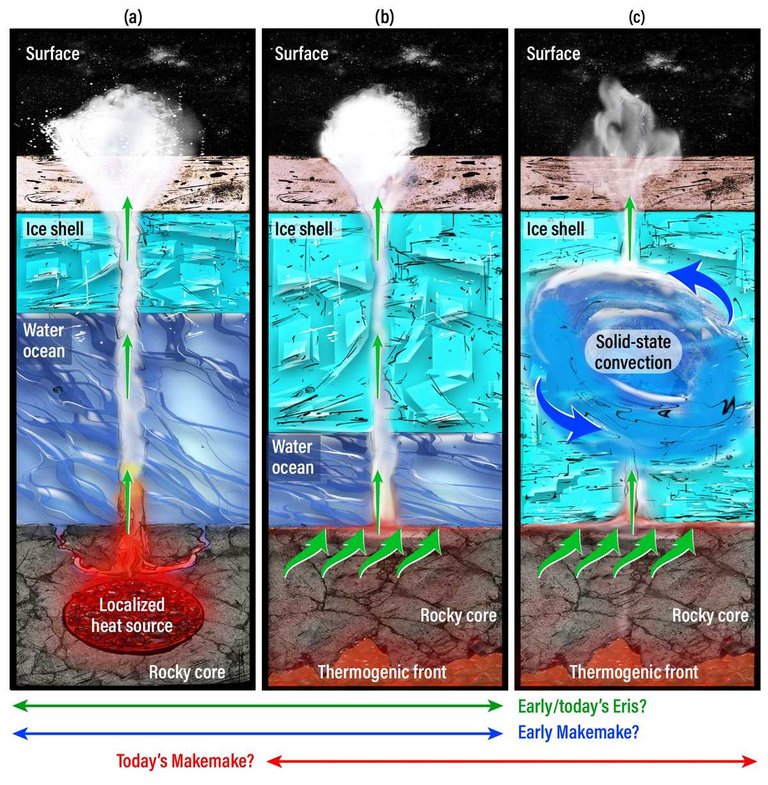More Kuiper Belt enigmas revealed

Souce
We have talked about the Voyager ships, specifically Voyager 1, in several publications, but these two NASA ships are not the only ones that are exploring the outer regions of the solar system, the Voyagers have technology from the 70s of the last century, But we have another ship with 21st century technology, it is the New Horizons, also from NASA.
The spacecraft that flew by Pluto and also the strange object 2014 MU nicknamed ultim tuule, New Horizons is now located on the outer edges of the Kuiper belt almost 60 times farther from the Sun than Earth is.

Souce
Thanks to the data that the spacecraft is sending us, scientists are discovering that the Kuiper belt, a region on the outside of our solar system and populated by hundreds of thousands of primitive building blocks of planets of which we know only a few, could extend much further than previously thought, it would be billions of kilometers more extensive, there may even be a second Kuiper belt beyond the one we know of.

Souce
In the Kuiper belt we have also found several dwarf planets, two of them Eris and Makemake are in the news because James Webb has detected signs of geological activity on them, which points to the presence of chemical activity inside these dwarf planets.
These small worlds are located very far from the Sun in an extremely cold region where elements that here on Earth are gases such as nitrogen, methane or carbon dioxide in Eris and Makemake are solid ice, as hard as rocks.

Souce
But, although it is very cold, these two objects are quite large, Eris is 2326 km in diameter and Makemake is about 1430 km in diameter and that makes it possible that they can store some heat in their internal cores, the heat can come from infrequent collisions or rather from the decay of radioactive isotopes.
In particular, this can occur in Eris, which has a high density, which suggests that it may have a relatively large rock core. This heat would cause some ice to evaporate, creating the geological activity that has now been detected and perhaps also promoting the formation of organic molecules.
We are only at the beginning of exploring the outer regions of the solar system, and these findings are just the beginning of thousands of mysteries to be found there.
Source
Source
Thank you for visiting my blog. If you like posts about #science, #planet, #politics, #rights #crypto, #traveling and discovering secrets and beauties of the #universe, feel free to Follow me as these are the topics I write about the most. Have a wonderful day and stay on this great platform :) :)
! The truth will set us free and science is the one that is closest to the truth!
Mais enigmas do Cinturão de Kuiper revelados

Souce
Já falamos sobre as naves Voyager, especificamente a Voyager 1, em diversas publicações, mas essas duas naves da NASA não são as únicas que estão explorando as regiões externas do sistema solar, as Voyagers possuem tecnologia da década de 70 do século passado, mas temos outra nave com tecnologia do século 21, é a New Horizons, também da NASA.
A espaçonave que passou por Plutão e também o estranho objeto 2014 MU apelidado de ultim tuule, New Horizons está agora localizada nas bordas externas do cinturão de Kuiper, quase 60 vezes mais longe do Sol do que a Terra.

Souce
Graças aos dados que a sonda nos está a enviar, os cientistas estão a descobrir que a cintura de Kuiper, uma região fora do nosso sistema solar e povoada por centenas de milhares de blocos de construção primitivos de planetas dos quais conhecemos apenas alguns, poderia estender-se muito mais longe do que se pensava anteriormente, seria milhares de milhões de quilómetros mais extenso, podendo até existir uma segunda cintura de Kuiper para além daquela que conhecemos.

Souce
No cinturão de Kuiper também encontramos vários planetas anões, dois deles Eris e Makemake estão nos noticiários porque James Webb detectou neles sinais de atividade geológica, o que aponta para a presença de atividade química dentro desses planetas anões.
Esses pequenos mundos estão localizados muito longe do Sol, em uma região extremamente fria onde os elementos que aqui na Terra são gases como nitrogênio, metano ou dióxido de carbono em Eris e Makemake são gelo sólido, duro como rochas.

Souce
Mas, apesar de ser muito frio, estes dois objetos são bastante grandes, Eris tem 2326 km de diâmetro e Makemake tem cerca de 1430 km de diâmetro e isso permite que possam armazenar algum calor nos seus núcleos internos, o calor pode vir de colisões infrequentes ou melhor, do decaimento de isótopos radioativos.
Em particular, isto pode ocorrer em Eris, que tem uma alta densidade, o que sugere que pode ter um núcleo rochoso relativamente grande. Este calor faria com que algum gelo evaporasse, criando a atividade geológica que agora foi detectada e talvez também promovendo a formação de moléculas orgânicas.
Estamos apenas no início da exploração das regiões exteriores do sistema solar, e estas descobertas são apenas o início de milhares de mistérios que aí podem ser descobertos.
Source
Fonte
Obrigado por visitar meu blog. Se você gosta de posts sobre #ciência, #planeta, #política, #direitos #cripto, #viajar e descobrir segredos e belezas do #universo, fique à vontade para me seguir, pois esses são os assuntos sobre os quais mais escrevo. Tenha um dia maravilhoso e fique nesta ótima plataforma :) :)
! A verdade nos libertará e a ciência é a que está mais próxima da verdade!








Obrigado por promover a comunidade Hive-BR em suas postagens.
Vamos seguir fortalecendo a Hive